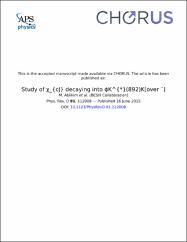| dc.contributor.author | The BESIII collaboration | en_US |
| dc.contributor.author | Kolcu, Onur Buğra | en_US |
| dc.date.accessioned | 2019-10-29T17:49:38Z | |
| dc.date.available | 2019-10-29T17:49:38Z | |
| dc.date.issued | 2015 | |
| dc.identifier.issn | 1550-7998 | |
| dc.identifier.uri | https://dx.doi.org/10.1103/PhysRevD.91.112008 | |
| dc.identifier.uri | https://hdl.handle.net/20.500.12294/2233 | |
| dc.description.abstract | Using a data sample of 106 million ?(3686) events collected with the BESIII detector operated at the BEPCII storage ring, we study for the first time the decays ?cJ??KS0K±?? and ?cJ??K+K-?0 in the E1 radiative transition ?(3686)???cJ. The decays are dominated by the three-body decay ?cJ?K?(892)K¯. We measure branching fractions for this reaction via the neutral and charged K?(892) and find them consistent with each other within the expectation of isospin symmetry. In the KK¯? invariant mass distribution, a structure near the K?(892)K¯ mass threshold is observed, and the corresponding mass and width are measured to be 1412±4(stat)±8(sys)MeV/c2 and ?=84±12(stat)±40(sys)MeV, respectively. The observed state favors an assignment to the h1(1380), considering its possible JPC and comparing its mass, width and decay mode to those reported in the Particle Data Group. © 2015 American Physical Society. | en_US |
| dc.language.iso | eng | en_US |
| dc.publisher | American Physical Society | en_US |
| dc.relation.ispartof | Physical Review D - Particles, Fields, Gravitation and Cosmology | en_US |
| dc.identifier.doi | 10.1103/PhysRevD.91.112008 | en_US |
| dc.identifier.doi | 10.1103/PhysRevD.91.112008 | |
| dc.rights | info:eu-repo/semantics/openAccess | en_US |
| dc.title | Study of ?cJ decaying into K? (892) K ¯ | en_US |
| dc.type | article | en_US |
| dc.department | İstanbul Arel Üniversitesi, Meslek Yüksekokulu, Optisyenlik Programı | en_US |
| dc.identifier.volume | 91 | en_US |
| dc.identifier.issue | 11 | en_US |
| dc.relation.publicationcategory | Makale - Uluslararası Hakemli Dergi - Kurum Öğretim Elemanı | en_US |


















